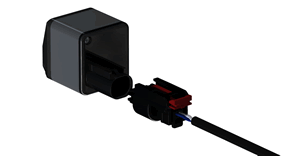Making a connection with sensors, microcontrollers
Microcontrollers and sensors are generally seen as the dominant devices leading the growth of automotive electronics. But basic electromechanical components like connectors are key enablers in the drive to add more features and functions.
 The digital revolution in autos wouldn’t be possible without continued improvements in connectors, which are seeing stable growth. The connector content of the automotive market could slightly exceed $16 billion in 2021, compared to just under $12.3 billion in 2014, according to Bishop & Associates.
The digital revolution in autos wouldn’t be possible without continued improvements in connectors, which are seeing stable growth. The connector content of the automotive market could slightly exceed $16 billion in 2021, compared to just under $12.3 billion in 2014, according to Bishop & Associates.
“A low-cost car such as a Tata Nano manufactured in India contains between 100 and 120 connectors,” said Dennis Smith, Bishop’s Automotive Segment Director. “A fully loaded luxury vehicle, such as a BMW 7 Series, contains between 450 and 500 connectors.”
Market growth is coming even as engineers throughout the industry attempt to reduce the number of connectors. Connectors are getting larger, providing more inputs and outputs (I/Os) while also adding a few components so passives and other devices don’t have to consume circuit board space.

Connectors from Molex let engineers add sensors and other components.
“The overall net change in shipments is flattening in terms of connector quantity,” said Mike Gardner, Advanced Technology Marketing Manager at Molex. “However, the remaining connectors are becoming more complex due to more sophisticated devices, modules and networking efforts.”
These modules and networking are appearing on more mainstream cars, not just on luxury vehicles, augmenting sales growth that’s coming as car sales in China and India soar. Electronic control units are performing more functions and communicating with more electronic modules. That often drives up the demand for connections, so the number of pins in connectors is growing rapidly.
“Pin counts are going well above 200 I/Os. Our largest has almost 300 pins, which is quite a change from 150 pins just a few years ago,” said Tom Anderson, Interconnect Product Manager at AVX. “The next step will be to go to finer pitch, 2 mm or less.”
Reducing the pitch, or the space between contacts, helps developers build higher density connectors without significant size increases. The need to handle more sensor inputs and talk to multiple modules is particularly acute in engines where fuel consumption regulations are forcing engineers to do more to precisely control engine operations.
“Integration in engine control units has forced higher density pin count within a given module or device,” Gardner said. “A range of single- and dual-row, and stackable connector systems use smaller pin, terminal, and wire sizes in signal and low-current electrical circuits. Compact connectors reduce overall size and the design complexity of integrated systems.”
Connectors are also helping reduce complexity by incorporating more components. Passives and other components are routinely being embedded in connector bodies.
“Connectors are integrated with sub-assemblies,” Anderson said. “One module has bus bars, capacitors and bushings all in one connector.”
Connector makers have also made changes to enhance reliability. For example, manufacturers have moved away from soldering each pin onto the board. Instead, press fit contacts are pressed into plated holes in the circuit board.
“Higher pin count connectors have gone to press fit pins, they’ve proven very reliable and they’re much simpler to produce,” Anderson said. “Pin diameters are moving from 0.6 mm to 0.4 mm.”
Recently posted:
[related_posts limit=”10″]
- State of the Industry: 2022-2023 Connector Sales - April 16, 2024
- Amphenol is On a Roll - April 2, 2024
- Nicomatic Proves That Two Heads are Better Than One - March 26, 2024






